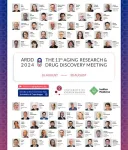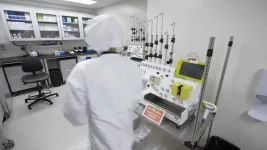(Press-News.org) An estimated one in six people suffer from a brain disorder worldwide, according to the American Brain Foundation. Current research has provided some insight into cell-communication inside the brain, but there are still a lot of unknowns surrounding how this crucial organ functions. What if there was a comprehensive map that took into consideration not just the biology of the brain, but the specific location where the biology occurs?
Researchers in the College of Engineering have developed a powerful, cost-effective method to do just that.
Chang Lu, the Fred W. Bull Professor of Chemical Engineering, has been leading a research project that could be groundbreaking for brain research. The newly published article in the journal Cell Reports Methods features interdisciplinary research along with faculty in two additional departments within the College of Engineering:
Xiaoting Jia, associate professor in the Bradley Department of Electrical and Computer Engineering
Daphne Yao, professor in computer science and affiliate faculty at the Sanghani Center for Artificial Intelligence and Data Analytics
Their goal? Mapping and visualization of the brain biology at genome scale in the most cost-effective way possible to improve healthy functioning.
“Many of the facts about the brain are phenomenological, meaning that we know it happens, but we don't necessarily understand molecular activities underlying these events. I think this has been hindering the development of drugs,” said Lu. “Treating brain disorders has historically been done not by rational design, but by trial and error. By having a reference map that explains how different parts of the brain operate at a molecular level, this can help researchers begin to develop different treatment options.”
What’s new in brain mapping
Brain health is largely determined by gene activities in brain cells. When researchers talk about genetics, they are essentially referring to the DNA sequence and how it affects human health. For example, if something is wrong or altered within the sequence, then certain diseases can be diagnosed. Research has revealed that there can be other chemical changes occurring in the brain that do not alter the DNA sequence, but change how other molecules interact with DNA. This change that influences gene activity without altering the DNA sequence is known as epigenomics, and it can be equally responsible for changing the gene activity inside the brain and causing various diseases.
Lu and his colleagues are interested in exploring how brain epigenomics can be altered in various brain regions in response to activity changes or specific conditions like seizures, epilepsy, addiction, or other mental diseases. The current process of brain mapping involves profiling single cells one by one. While this approach offers high spatial resolution and presents important information about cell-communication inside the brain, it is costly and tedious. Lu and his team have developed a more cost-effective approach to the spatial method: epigenomic tomography.
Epigenomic tomography involves the creation of a detailed map of the epigenome, or the genome-scale profile of the epigenetic change, across a large area and volume of the brain. Lu believes this is an important method for scientists to use to understand the genetic and environmental factors that affect the ways genes behave outside of DNA sequences.
“When a person has a seizure, struggles with addiction, or suffers from any kind of brain disorder, they experience epigenomic alteration in the brain,” Lu said. “Creating a reference map of the brain to display what healthy brain epigenomes look like across various regions can provide a helpful point of comparison for when the brain suffers a change, such as a seizure.”
The future of drug development
Through their collaborative process, the research team was able to create a map that demonstrates when the brain is experiencing a seizure versus when it is experiencing normal activity. Here’s their interdisciplinary approach:
Divide the brain into small sections, about 0.5 mm in thickness. These sections are registered, meaning the researchers know where a particular section is from in terms of the location and region of the brain.
Profile each one of the sections separately using their low-input technology developed in Lu’s lab.
Group features across these sections into clusters based on their spatial variation patterns using clustering algorithms with help from Yao.
Create brain tomographies for both healthy and diseased brains, with assistance from Jia’s model for investigating the effects of seizures and other brain disorders.
Once the digital tomography of the brain is reassembled, the researchers have a map that is characteristic of the brain’s epigenome across a significant area. When the map changes, this reflects a significant change in terms of how the brain is performing at the epigenomic level, which Jia says is groundbreaking for understanding brain disorders.
“The missing piece to the puzzle is the fundamental understanding of the seizure process at the molecular level across a spatially distributed brain region,” said Jia. “Our method provides a powerful tool that allows us to investigate the molecular processes in the brain underlying seizure.”
The results of their spatial epigenomic profiling will further help researchers understand how cells across various regions of the brain behave differently in terms of their epigenetic signatures. This cost-effective method also helps ensure that a sizable number of brain samples can be studied, something that yields statistical significance for the result.
Funding for their research came from a variety of sources who are interested in future drug development for neurological disorders, including:
National Institute of General Medical Sciences
National Institute on Drug Abuse
National Institute of Neurological Disorders and Stroke
Lu believes his team’s brain mapping method could make a big impact on drug development for brain disorders. He said, “We hope more researchers will join us in terms of making progress on brain disorders. It’s important research for people suffering from depression and addiction. That’s a large percentage of our population.”
Collaboration inside the lab
This interdisciplinary collaboration required specialties from all three departments. The research team was supported by the College of Engineering and the Institute for Critical Technology and Applied Sciences Center for Engineered Health.
“Our findings wouldn’t have been possible without the close collaboration across multiple disciplines,” Jia said. “It’s really exciting to see that epigenomic tomography facilitates the understanding of spatially dynamic processes across a large brain area underlying seizure, and I expect it can enable applications in a wide range of brain diseases in the future.”
So what does research on the brain have to do with engineering? To Lu, this was the perfect project for a chemical engineer.
“The technology development part of this project is how you might traditionally think of engineering: solving a problem, designing an approach, and developing the technology. But I feel chemical engineers are particularly equipped with the vast skill set of chemistry, biology, and data analysis. Each of these aspects are involved in this project, one way or another,” said Lu. “When my students graduate, I believe they can do all of these things and see the importance of each of them in their work.”
The engineering expertise used in this project did not stop there. Yao used statistical algorithms to simplify and organize massive epigenomic data, making meaningful patterns stand out, such as how healthy and diseased brains’ epigenomes differ.
“The amount of biological data generated in this project is huge, requiring the design of customized data processing methods tailored for this specific problem,” Yao said. “It is super exciting to see clustering algorithms being used for biomedical research - something to brag about next time I teach machine learning.”
END
New spatial profiling approach maps out discoveries for future brain research
Researchers in the College of Engineering have developed a cost-effective method to spatially characterize and map brain epigenomes.
2024-03-19
ELSE PRESS RELEASES FROM THIS DATE:
Family out-of-pocket expenditure on dental care
2024-03-19
Alexandria, VA, USA – A study aiming to determine if poorer families pay more for dental care as a proportion of their total income than richer families. was presented at the 102nd General Session of the IADR, which was held in conjunction with the 53rd Annual Meeting of the American Association for Dental, Oral, and Craniofacial Research and the 48th Annual Meeting of the Canadian Association for Dental Research, on March 13-16, 2024, in New Orleans, LA, USA.
The abstract, ...
11th ARDD Meeting Announces initial stellar speaker lineup and XPRIZE Healthspan Team Summit
2024-03-19
According to the United Nations, the proportion of people aged over 65 now outnumber children younger than 5. The enormous growth in the elderly population is posing a socioeconomic challenge to societies worldwide, and necessitates new sweeping interventions for age-associated diseases. This year we have an incredibly exciting program with global thought-leaders sharing their latest insights into aging and how we target the aging process ensuring everyone lives a healthier and longer life. Welcome to the 11th Aging Research and Drug Discovery Meeting.
This year, ARDD is proud to be a partner of XPRIZE ...
Cell therapy approach harnesses the immune system in a different way to stop cancer
2024-03-19
NOTE TO EDITORS: High-resolution b-roll, soundbites and images are available for download at https://bit.ly/3PfnX5Y
COLUMBUS, Ohio – A new cancer treatment that uses a person’s own immune cells has been approved by the U.S. Food and Drug Administration (FDA) for treating the most dangerous type of skin cancer. Now this form of cellular therapy (tumor-infiltrating lymphocyte – or TIL therapy) is showing promise in advanced lung cancers through clinical trials underway at The Ohio State University Comprehensive Cancer ...
Artificial intelligence algorithms for understanding the determinants of oral health
2024-03-19
Alexandria, VA, USA – A study aiming to use AI and predictive models to forecast the likelihood of permanent tooth loss, as an indicator of overall oral health, based on various behavioral and lifestyle factors was presented at the 102nd General Session of the IADR, which was held in conjunction with the 53rd Annual Meeting of the American Association for Dental, Oral, and Craniofacial Research and the 48th Annual Meeting of the Canadian Association for Dental Research, on March 13-16, 2024, in New Orleans, LA, USA.
The abstract, “Artificial Intelligence Algorithms for Understanding the Determinants of Oral Health” was presented during ...
Predicting oral cancer-related mortality among adults using machine learning approach
2024-03-19
Alexandria, VA, USA – A study aiming to predict oral cancer-related mortality among adults in the United States and identify the predictors of oral cancer-related mortality using the Machine Learning Approach. was presented at the 102nd General Session of the IADR, which was held in conjunction with the 53rd Annual Meeting of the American Association for Dental, Oral, and Craniofacial Research and the 48th Annual Meeting of the Canadian Association for Dental Research, on March 13-16, 2024, in New Orleans, LA, USA.
The abstract, “Predicting Oral Cancer-Related Mortality among Adults Using Machine Learning Approach” was presented ...
Harnessing biomaterial-based FTY720 immunotherapy to accelerate oral wound healing
2024-03-19
Alexandria, VA, USA – A study aiming to deliver Fingolimod (FTY720) loaded polymer scaffolds to enhance oral wound healing by modulating pro-regenerative immune cell migration associated with improved vascularization and tissue remodeling was presented at the 102nd General Session of the IADR, which was held in conjunction with the 53rd Annual Meeting of the American Association for Dental, Oral, and Craniofacial Research and the 48th Annual Meeting of the Canadian Association for Dental Research, on March 13-16, 2024, in New Orleans, LA, USA.
The abstract, “Harnessing Biomaterial-Based ...
Oral health behaviors associated with mental health disorders
2024-03-19
Alexandria, VA, USA – A study aiming to examine oral hygiene self-care behavior among patients with self-reported mental health disorders was presented at the 102nd General Session of the IADR, which was held in conjunction with the 53rd Annual Meeting of the American Association for Dental, Oral, and Craniofacial Research and the 48th Annual Meeting of the Canadian Association for Dental Research, on March 13-16, 2024, in New Orleans, LA, USA.
The abstract, “Oral Health Behaviors Associated with Mental Health Disorders” was presented during the ...
Researchers develop deep learning model to predict breast cancer
2024-03-19
OAK BROOK, Ill. – Researchers have developed a new, interpretable artificial intelligence (AI) model to predict 5-year breast cancer risk from mammograms, according to a new study published today in Radiology, a journal of the Radiological Society of North America (RSNA).
One in 8 women, or approximately 13% of the female population in the U.S., will develop invasive breast cancer in their lifetime and 1 in 39 women (3%) will die from the disease, according to the American Cancer Society. Breast ...
Social activities can prevent cognitive decline in care facility residents
2024-03-19
Social activities such as interactions with others and participation in organised events can prevent cognitive decline in long-term care facility. Research from Amsterdam UMC, carried out among 3600 patients in 42 Dutch and Belgian care homes, shows that participation in social activities offers a protective effect for those with no, or little, cognitive impairment. These results are published today in the Journal of Alzheimer's Disease.
"Cognitive decline in long-term care residents is relatively common, a Canadian study showed that almost a quarter of residents cognitively declined after a year of residency," ...
BU study finds coping is related to longevity in older men
2024-03-19
(Boston)—Coping is defined as cognitive and behavioral efforts to manage stressors that people believe exceed their ability and resources to respond to effectively. While previous research has linked stressor characteristics, such as the type of event and its duration, and how stressed people feel in response to them, to higher mortality risk, far fewer studies have considered the long-term health consequences of how we manage stressors (coping) in large-scale studies.
In a new study from ...
LAST 30 PRESS RELEASES:
Two Keck Medicine of USC Hospitals named Leapfrog Top Teaching Hospitals
World-first discovery uncovers how glioblastoma tumours dodge chemotherapy, potentially opening the door to new treatments
A fatal mix-up: How certain gut bacteria drive multiple sclerosis
New AI tool identifies not just genetic mutations, but the diseases they may cause
Deep-learning model predicts how fruit flies form, cell by cell
Combination pills for high blood pressure may simplify treatment, improve long-term health
Immune system keeps mucosal fungi in check
Neurons within the brain use simple rules to localize genetic messages
Electrodes created using light
Second-hand gift-giving is a well-deliberated decision
How human interaction drove evolution to make bears less aggressive
National Poll: Few parents offer teens guidance on healthy eating during holiday season
Cannabis derivatives could provide new ovarian cancer treatments
Raising strong yeast as a petroleum substitute
Clues to the origin of hot Jupiters hidden in their orbits
Canada’s reduced pledge to Global Fund will impact domestic health
1 in 4 children with major traumatic injuries not cared for in pediatric trauma centres
Duke and Duke-NUS’ joint cross-population research to uncover "East-West" differences in disease and care
Scientists to ‘spy’ on cancer- immune cell interactions using quantum technology breakthrough
Tech savvy users have most digital concerns
Making lighter work of calculating fluid and heat flow
Normalizing blood sugar can halve heart attack risk
Lowering blood sugar cuts heart attack risk in people with prediabetes
Study links genetic variants to risk of blinding eye disease in premature infants
Non-opioid ‘pain sponge’ therapy halts cartilage degeneration and relieves chronic pain
AI can pick up cultural values by mimicking how kids learn
China’s ecological redlines offer fast track to 30 x 30 global conservation goal
Invisible indoor threats: emerging household contaminants and their growing risks to human health
Adding antibody treatment to chemo boosts outcomes for children with rare cancer
Germline pathogenic variants among women without a history of breast cancer
[Press-News.org] New spatial profiling approach maps out discoveries for future brain researchResearchers in the College of Engineering have developed a cost-effective method to spatially characterize and map brain epigenomes.



